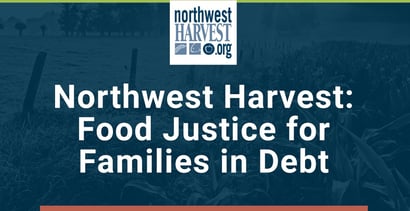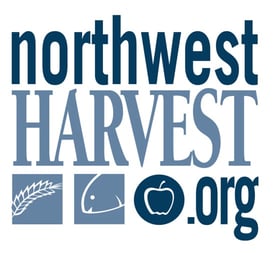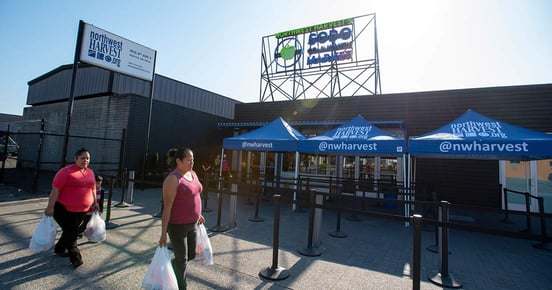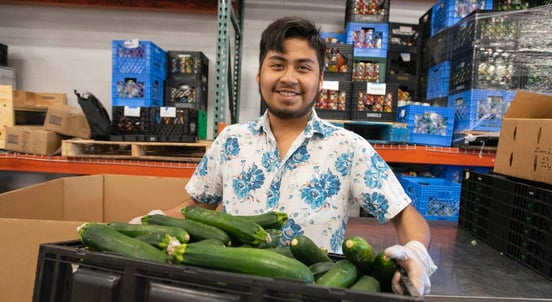

In a Nutshell: Nearly 13% of Americans have struggled with food insecurity in 2021. In Washington State, many of them turned to Northwest Harvest for help. The organization, established in 1967, and its partners collect donations and distribute food to individuals and families in need. In 2020, Northwest Harvest saw a significant increase in demand but a decrease in supply due to disruptions wrought by the COVID-19 pandemic. This challenging period has served to underscore the systemic problems that cause food insecurity, and Northwest Harvest is committed to advocacy that aims to alleviate food insecurity through thoughtful legislation.
As many as 42 million Americans — nearly 13% of the population — may experience food insecurity by the close of 2021, according to Feeding America. That is an increase of close to 4 million people from 2020, and many of those affected households don’t qualify for federal nutritional assistance programs. As a result, they often turn to hunger relief agencies like Northwest Harvest in Washington State.
“We have a deep commitment to addressing the needs of people facing food insecurity today and get at the systemic causes behind it,” said Laura Hamilton, Chief Advancement Officer at Northwest Harvest. “And we understand that food insecurity is far more than having the means to put food on the table. It’s about how people access that food.”

Northwest Harvest began as a single hunger response program serving the Seattle area in 1967. Today, it continues to pursue its founding ideal: providing people with food with dignity. When someone needs food, Northwest Harvest provides it, no questions asked. They don’t need to provide their name, ZIP code, or identifying information of any kind.
Over the decades, the Northwest Harvest mission has become more crucial to its communities. In the 1980s, Boeing was a major employer in the region. But when the company made significant cutbacks, it led to unemployment, debt, and greater need in the Northwest.
Northwest Harvest recognized the growing need for basic food staples and established its own distribution center and a network of partner food banks, food pantries and meal programs in the 1980s.
“That meant we could use our purchasing power to buy food, accept large-scale food donations, and distribute them to the smaller food banks, meal programs, and food pantries across the state. We consider that our network of partners,” Laura said. “And we expanded that network through the years. Today, we have more than 300 partners, and we’re in every county in the state.”
SODO Community Market Delivers Food to People in Need
Many Northwest Harvest partners work directly with food-insecure populations, including homeless communities. The organization has traditionally delivered food to people in need through that network.
In June 2019, Northwest Harvest opened the SODO Community Market, which is a free grocery store. It’s a novel approach to combating food insecurity by making the experience more like a trip to a grocery store — but without the price tag. That fights hunger and the stigma around receiving aid.

“People come in and have a shopping experience much like they would if they were going to Trader Joe’s, except they don’t pay when they leave,” Laura said. “The neighborhood that it’s located in, the SODO community in South Seattle, has a large unhoused population surrounding it, so we do see a lot of people coming in.”
Northwest Harvest depends on donations to meet this and other community food needs. Its partnership with Starbucks furnishes prepared food, which is beneficial to people who don’t have a place to cook. They can obtain food that’s nutritious and ready to eat.
The market operates three days a week during set hours, but if people come outside of those hours, Laura said they wouldn’t be turned away. Northwest Harvest has prepared meal packages, pre-made meals, and bottled water on hand to ensure no one goes hungry, no matter the time of day.
COVID-19 Challenged its Volunteer and Distribution Models
The rise in food insecurity from 2020 to 2021 was due in no small part to the COVID-19 pandemic. Employers cut hours, furloughed, and laid off employees. At the same time, people experienced reduced wages and debt, grocery stores dealt with reduced stock, and food scarcity caused prices to increase.
That affected Northwest Harvest’s operations and mission. Before the pandemic, Laura said that 90% of its stock came from donations. As people lost their jobs and the economy slowed during the pandemic, Northwest Harvest found itself with more people in need and fewer donations.
“It wasn’t so much that the food didn’t exist; it was that there were all these disruptions in the supply chain,” Laura said. “That impacted us, and our model of donated versus purchased food during the pandemic was actually at an inverse at one point. We were purchasing 90% of what we were distributing.”

Northwest Harvest was also forced to curtail its volunteer program — the main driver behind food distribution. Volunteers previously received, sorted, and packed the food, but those operations were suspended for everyone’s safety.
Northwest Harvest’s distribution model also shifted to handing out pre-packaged boxes of food to recipients. In lieu of volunteers, the Washington National Guard stepped in to sort and prepare the packages.
“We had about a 12-to-13-pound box of shelf-stable foods that contained a protein, green fruits, vegetables, or canned fruits and vegetables,” Laura said. “The guard was helping to pack that up. And then it was an effective way to distribute to our partners.”
Systemic Problems Pose Ongoing Challenges to Food Equity
For all its work in providing access to food for people in need, Northwest Harvest recognizes that its efforts only address a symptom of a larger problem. Food insecurity stems from systemic issues, including debt, that stakeholders must address to achieve real change.
“A lot of it is about access,” Laura said. “And that access is complicated by some of the systemic issues that come down to equity.”
Laura said that food insecurity disproportionately affects communities of color. This disparity is evident in underinvested neighborhoods that may have restaurants, but no grocery stores. This impedes access to affordable, nutritious food.
Rural communities likewise suffer from disproportionate food insecurity. In both cases, families have less money to budget for food due to debt, and they have lower-paying jobs and other expenses, including medical care.
The issues stem from financial duress and what Laura calls “time poverty.” People who work long hours and care for children don’t have the time to go grocery shopping, which many people take for granted.
“Decisions are being made on what type of investment will go into a community, and it affects them and their food options,” Laura said. “For a small business owner with a convenience store, there’s a big investment to make sure that they have access to something like produce, and that they have the appropriate shelf space in their store. It’s not as simple as saying the convenience stores need to start carrying some of these foods.”
Changing the Narrative to Combat Food Insecurity
One of the most significant challenges in combating food insecurity is ensuring people have access. But enabling that access is a complex problem with no simple solution. Hunger relief agencies and free markets are a stop-gap, not an end goal.
“We can’t distribute our way out of food insecurity,” Laura said. “There’s not going to be enough food.”
Real solutions will be based on the same principles that Northwest Harvest already relies on: collaborative partnerships and coalitions that increase basic access. Solutions will also need to disrupt the dominant narrative about who suffers from food insecurity.
Food insecurity is often associated with debt, poverty, and financial irresponsibility. But the events of 2020 and 2021 have shown that the problem runs much deeper. More people will confront food insecurity. According to projections in the State of Food Security and Nutrition in the World 2021, published by the Food and Agriculture Organization of the United Nations, the world’s hunger will not be eradicated unless bold actions are taken to accelerate progress, especially in addressing inequality in access to food.
Additional pandemic-related shutdowns will only aggravate the problems and force more people to choose between necessities, including rent and food.
“We’re doing what we can to address those issues,” Laura said. “And that’s how we plan to reduce food insecurity.”
Advertiser Disclosure
BadCredit.org is a free online resource that offers valuable content and comparison services to users. To keep this resource 100% free for users, we receive advertising compensation from the financial products listed on this page. Along with key review factors, this compensation may impact how and where products appear on the page (including, for example, the order in which they appear). BadCredit.org does not include listings for all financial products.
Our Editorial Review Policy
Our site is committed to publishing independent, accurate content guided by strict editorial guidelines. Before articles and reviews are published on our site, they undergo a thorough review process performed by a team of independent editors and subject-matter experts to ensure the content’s accuracy, timeliness, and impartiality. Our editorial team is separate and independent of our site’s advertisers, and the opinions they express on our site are their own. To read more about our team members and their editorial backgrounds, please visit our site’s About page.




